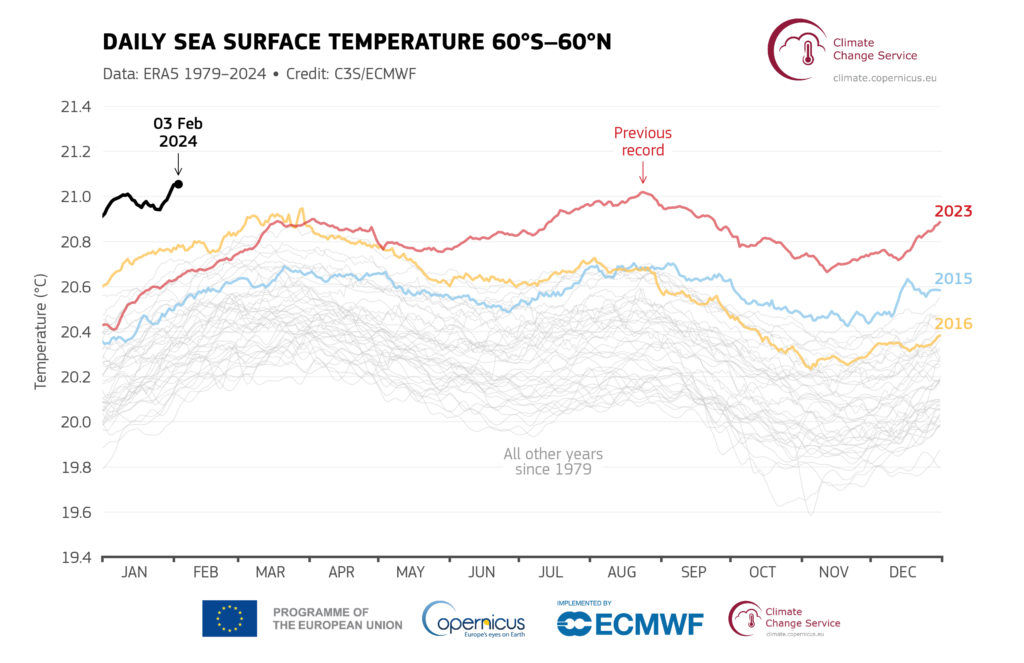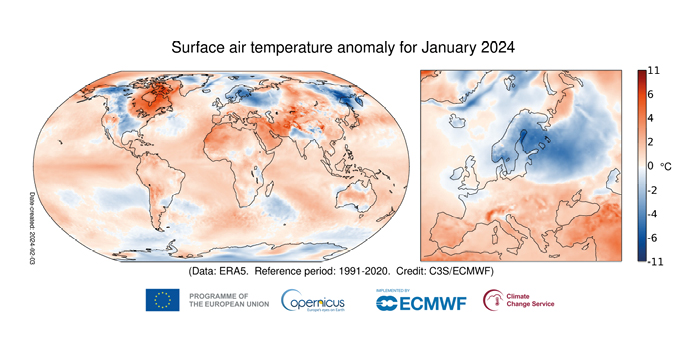The Copernicus Climate Change Service (C3S) has found that January 2024 was the warmest January on record globally, with an average ERA5 surface air temperature of 13.14°C, 0.70°C above the 1991-2020 average for January and 0.12°C above the temperature of the previous warmest January, in 2020.
C3S, implemented by the European Centre for Medium-Range Weather Forecasts on behalf of the European Commission with funding from the EU, routinely publishes monthly climate bulletins reporting on the changes observed in global surface air and sea temperatures, sea ice cover and hydrological variables. All the findings are based on computer-generated analyses and the ERA5 reanalysis data set, using billions of measurements from satellites, ships, aircraft and weather stations around the world.
This is the eighth month in a row that is the warmest on record for the respective month of the year. The global temperature anomaly for January 2024 was lower than those of the last six months of 2023, but higher than any before July 2023. The month was 1.66°C warmer than an estimate of the January average for 1850-1900, the designated pre-industrial reference period.
The global mean temperature for the past 12 months (Feb 2023 – Jan 2024) is the highest on record, at 0.64°C above the 1991-2020 average and 1.52°C above the 1850-1900 pre-industrial average. European temperatures varied in January 2024 from much below the 1991-2020 average over the Nordic countries to much above average over the south of the continent. Outside Europe, temperatures were well above average over eastern Canada, north-western Africa, the Middle East and central Asia, and below average over western Canada, the central USA and most of eastern Siberia.
El Niño began to weaken in the equatorial Pacific, but marine air temperatures in general remained at an unusually high level. The average global sea surface temperature (SST) for January over 60°S–60°N reached 20.97°C, a record for January, 0.26°C warmer than the previous warmest January, in 2016, and second highest value for any month in the ERA5 data set, within 0.01°C of the record from August 2023 (20.98°C). Since January 31, the daily SST for 60°S–60°N has reached new absolute records, surpassing the previous highest values from August 23 and 24, 2023.
Samantha Burgess, deputy director of the Copernicus Climate Change Service (C3S), said, “2024 starts with another record-breaking month – not only is it the warmest January on record but we have also just experienced a 12-month period of more than 1.5°C above the pre-industrial reference period. Rapid reductions in greenhouse gas emissions are the only way to stop global temperatures increasing.”
Arctic sea ice extent was close to average, and the highest for January since 2009. Sea ice concentrations were above average in the Greenland Sea (a persistent feature since October) and Sea of Okhotsk while below-average concentrations prevailed in the Labrador Sea. Antarctic sea ice extent was the sixth lowest for January, at 18% below average, well above the lowest January value recorded in 2023 (-31%). Below-average sea ice concentrations prevailed mainly in the Ross and Amundsen Seas, northern Weddell Sea, and along the coast of East Antarctica.
In January 2024, it was wetter than average in large parts of Europe, with storms affecting north- and south-western Europe. Drier-than-average conditions were seen in southeastern and northern Spain and the Maghreb, southern UK, Ireland, eastern Iceland, most of Scandinavia, part of north-western Russia, and the eastern Balkans.
Beyond Europe, it was wetter than average in several regions, including western and southeastern USA, a large region of Eurasia, southeastern South America, southeast Africa and northern and eastern Australia. Drier-than-average conditions were seen across parts of western and southern North America, Canada, the Horn of Africa, the Arabian Peninsula, and south-central Asia. Australia and Chile saw the dry conditions contribute to wildfires.
For more key climate measurement updates from the meteorological technology industry, click here.




